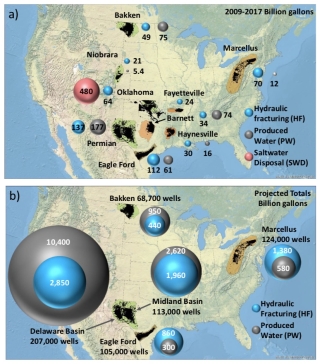Will Water Issues Constrain Oil and Gas Production in the U.S.?

Bridget R. Scanlon, Svetlana Ikonnikova, Qian Yang, and Robert C. Reedy
Environmental Science and Technology, https://doi.org/10.1021/acs.est.9b06390
Study Summary
The U.S. became the largest global oil (18 percent of global total) and natural gas (20 percent of total) producer in 2018, with unconventional oil and gas (UOG) accounting for ~60 percent of domestic oil and ~70 percent of natural gas supplies. However, there are concerns about adverse impacts on water. The objective of this study was to address the following:
- Might future water demands for hydraulic fracturing (HF) exceed water supplies?
- Might produced water (PW) management become a limiting factor for UOG production?
- What strategies can help to mitigate HF water demand and PW b) management issues?
In this study, we analyzed historical (2009–2017) HF water and PW volumes in eight major U.S. unconventional plays: four oil plays in semiarid regions (Bakken, Eagle Ford, Niobrara, and Permian) and four gas plays in humid regions (Barnett, Fayetteville, Haynesville, and Marcellus). We projected future HF water and PW volumes in select plays. We compared HF water demand to water supplies in different plays and examined water management strategies to mitigate water issues.
Results show that during the past nine years (2009–2017) an aggregated total lateral length of ~440×106 ft (134,000 km; ~73,000 wells) was drilled in the eight plays, equal to ~3× the Earth’s circumference (40,000 km). To fracture the rock, a total of ~480 billion gallons (Bgal) (~1,800 BL, 1.8 km3) of water was used. Total water withdrawal showed a marked increase in HF water use, depleting groundwater (GW) in some semiarid regions (e.g., by ≤58 ft [18 m]/yr in Eagle Ford). Water scarcity is projected in some regions within the Eagle Ford and Permian plays, where projected HF water demand exceeds planned GW depletion. Oil plays generated much more PW than gas plays, with the Permian producing ~15× more water than the Marcellus (2009–2017). The projected PW volume in the Permian Delaware Basin is equivalent to the capacity of Lake Mead, the largest U.S. surface-water reservoir, and equal to ~2× water use in Texas in 2017.
Water issues related to both HF water demand and PW supplies may be partially mitigated by closing the loop through reusing PW for HF of new wells. However, projected PW volumes exceed HF water demand in the semiarid Bakken (2.1×) and Permian Midland (1.3×) and Delaware (3.7×) oil plays, with the Delaware accounting for ~50 percent of projected U.S. oil production. Therefore, water issues may constrain future energy production, particularly in semiarid oil plays.
Why is this research important and why do the results matter?
-
Quantifying HF water demand relative to water supplies is critical in semiarid oil plays, with projected HF water demand exceeding GW supplies regionally within the Eagle Ford and Permian Basin plays without PW reuse.
-
Oil plays generate much more PW than gas plays, and subsurface disposal has been linked to induced seismicity, particularly in Oklahoma.
-
Water management can be improved by increasing reuse of PW for HF to reduce water scarcity and potential seismicity.
-
Projected excess PW relative to HF water demand may constrain future energy production, particularly in semiarid oil plays.